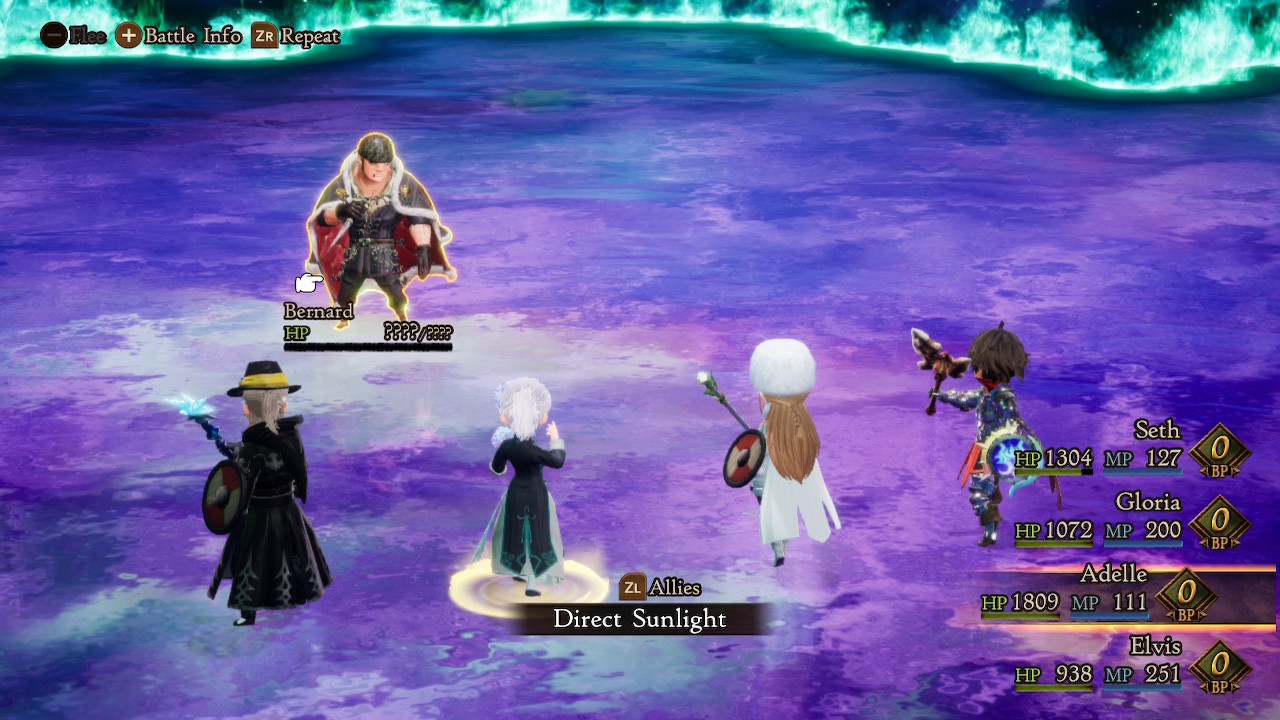
The Bravely Default series burst onto the 3DS in 2012. It brought back classic gameplay, aesthetic, and narrative Final Fantasy elements; along with a few tricks of its own. After the sequel to that game (Bravely Second) we now have a demo for the next entry, Bravely Default II.
For those unfamiliar with the gameplay, the main appeal is the Brave and Default system (also seen in Octopath Traveller). When guarding (Default) a character gains one Brave Point (BP). They can then spend that BP to take extra actions during their turn, or on some special abilities.
However characters can go in “debt” if they so choose, but not act while their BP total is negative. This leads to scenarios where you may go into debt to finish off a foe, or sacrifice future turns for a character to help deal with a crisis (usually your White Mage).
This same system also applies to enemies, each having their own patterns you slowly learn. Some enemies will gladly miss a future turn to pummel you, or stockpile BP to keep you on edge for when they’ll drop the boot. Others, especially bosses, change their behavior as they lose health.
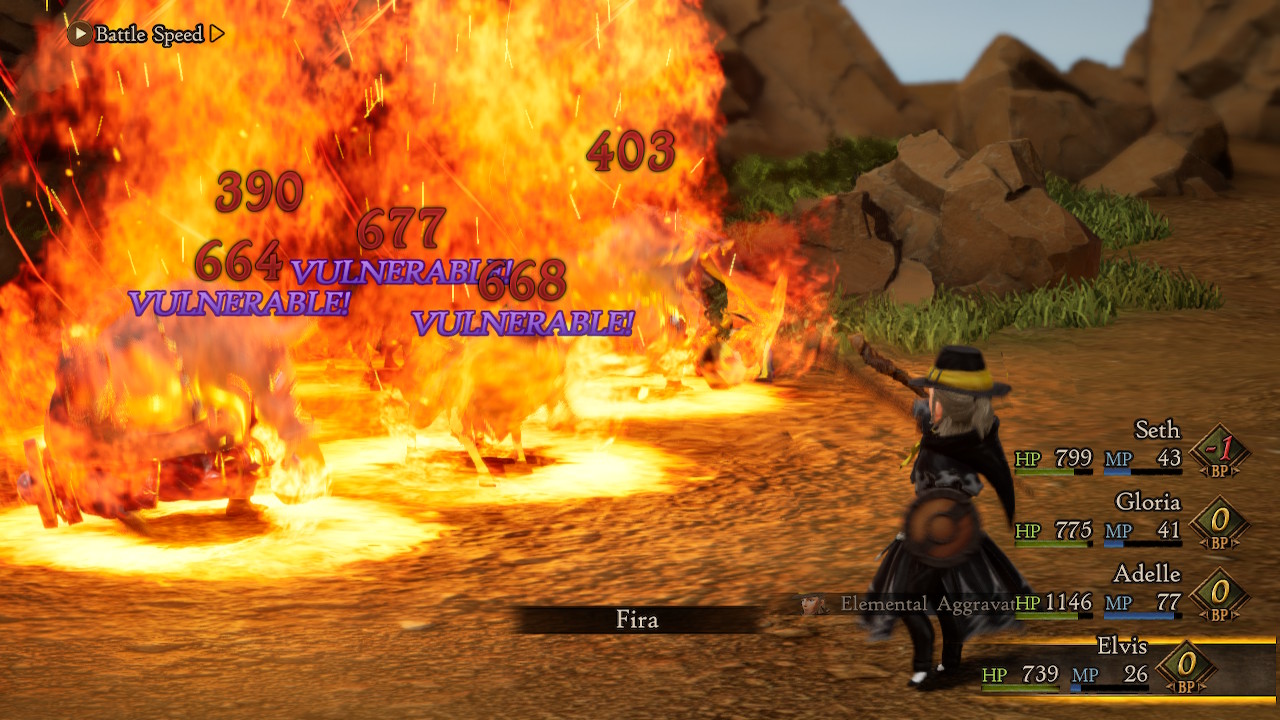
You might think the best tactic is to stock up the maximum 3 BP on each character, then unleash a barrage that devastates your foes. Making the most of every action you can is essential for tougher foes, and waiting for the perfect time may result in you soaking up too much damage, or giving enemies time to set-up their own assault.
The demo is designed to compact the overall experience (with characters growing quickly), and you are freely allowed to run into encounters you are under-equipped or under-leveled for. A powerful foe acting more than once in a turn can ruin you, demanding a better strategy, or doing a little grinding against weaker foes.
That being said, the demo does a terrible job at encouraging you to explore. After collecting a few wolf pelts for a side quest, I found I didn’t need to explore the rest of the overworld before going into the first- and only- dungeon.
You’ll only miss out on gear you can still otherwise buy, and some area-exclusive foes. I only went to the other half of the world I could access to fight a post-game boss, and only then learned of other enemy types I had long-since surpassed.
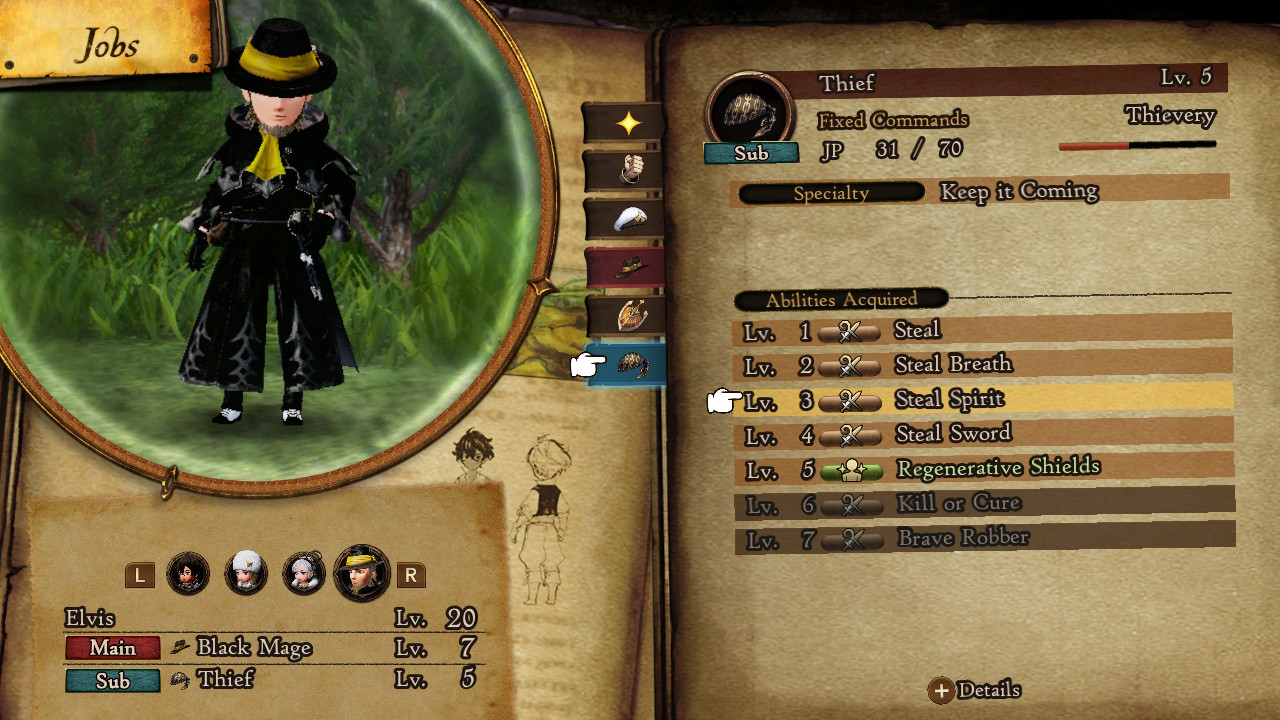
Characters gain both EXP and JP from battle- Job Points. These help improve the Job (class) they are currently assigned. As jobs level up, characters learn more skills to use in battle, along with passive abilities.
You usually end up building a character around a role, utilizing their main Job (which comes with skills, and one class-specific passive), a sub Job (giving them access to the skills of another class), and other learned passive abilities from any class (up to three points worth in the demo).
Jobs are mastered at a very quick rate (for the sake of the demo), giving you more chance to play with how everything synergizes. For example, the Monk’s specialty is a boost to critical hit rate for every BP spent in a turn. This works well alongside the Vanguard’s critical hit damage boosting passive, its ability to gain BP when attacked while guarding, or both.
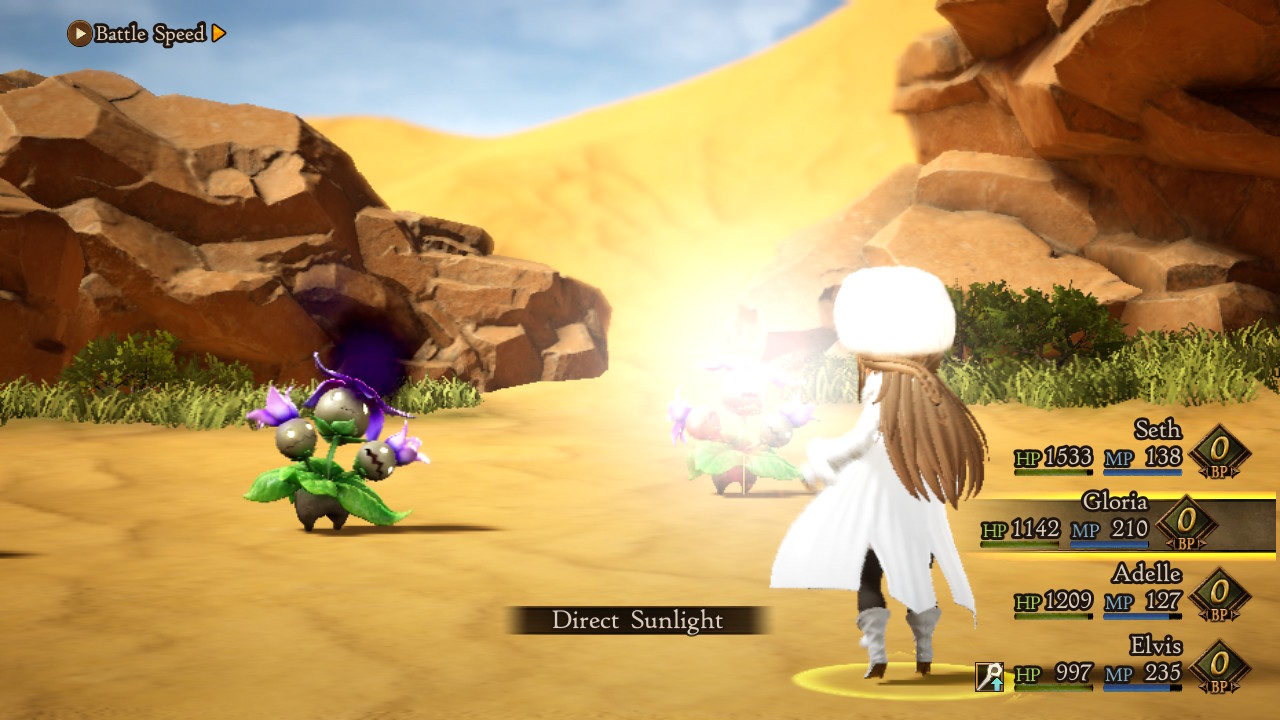
This led to some game-breaking (and at times necessary) combinations in past games. The demo’s two “post-game” super bosses perfectly demonstrate how not only the right Jobs and abilities are essential for tougher foes, but also how some combinations can break the whole encounter.
This is far from a criticism however. There is joy to be had in working out how to make an enemy a cake-walk (as oppose to using a guide for the answer). The crux will be how easily these powerful combinations can be worked out, how quickly Jobs level up in the final game, and the individual balance of skills.
For example, the Thief can steal BP from a foe, at a 50% success rate. This doesn’t seem to overpowered, until you consider that multiple characters can be assigned the same Job. When fighting a single target (such as a boss), it is possible to deny them a round or two with three or so Thieves, while the remaining characters set-up.
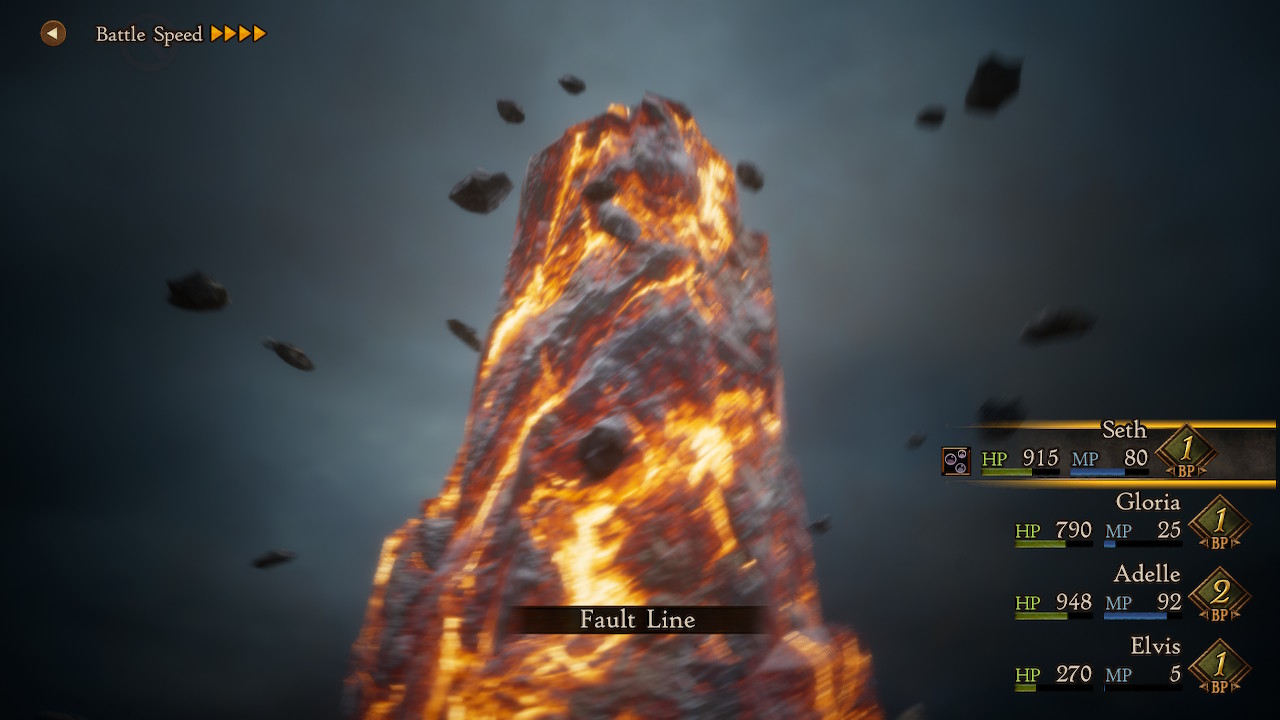
While only limited to one character in the demo, the Special Attacks return. Each Job has its own special attack (rather than each weapon type as in past titles), and they can be performed when meeting specific criteria. This usually using that Job’s skills a certain number of times, or things that fit their playstyle.
These attacks not only hit hard, but they provide huge buffs while that character’s theme music is playing. Unfortunately, Seth’s theme seems to end rather abruptly, giving little warning. The song does have an ending flourish (thanks to those who have ripped the tracks from the game), so it appears to be a mere oversight.
In past games, the buffs could be extended and chained onto other special attacks, encouraging you to act quickly. This also gives incentive to speed up the animations of battle. While a great feature, you have no way to slow down the animations while in menus. This means a new attack can fly past without you noticing. It makes you wish for a “don’t speed past new attacks” option- however feasible that might be.

An interesting new addition is weight on equipment, and weight limits based on a character’s main Job. There is nothing stopping your Black Mage from wearing plate mail, but if they become overburdened their stats will tumble.
It’s a great way of preventing some of the more broken combinations based on gear, but may allow players some freedom. Maybe you want your Black Mage wearing plate mail, you will just have to use something much lighter in another slot (and usually with worse stats), or leave it empty.
Gear also shows how much aggro it generates now, letting the player know who is going to be taking most of the attacks. Even so, it is a percentage chance, and some enemies pack whole-party assaulting moves.
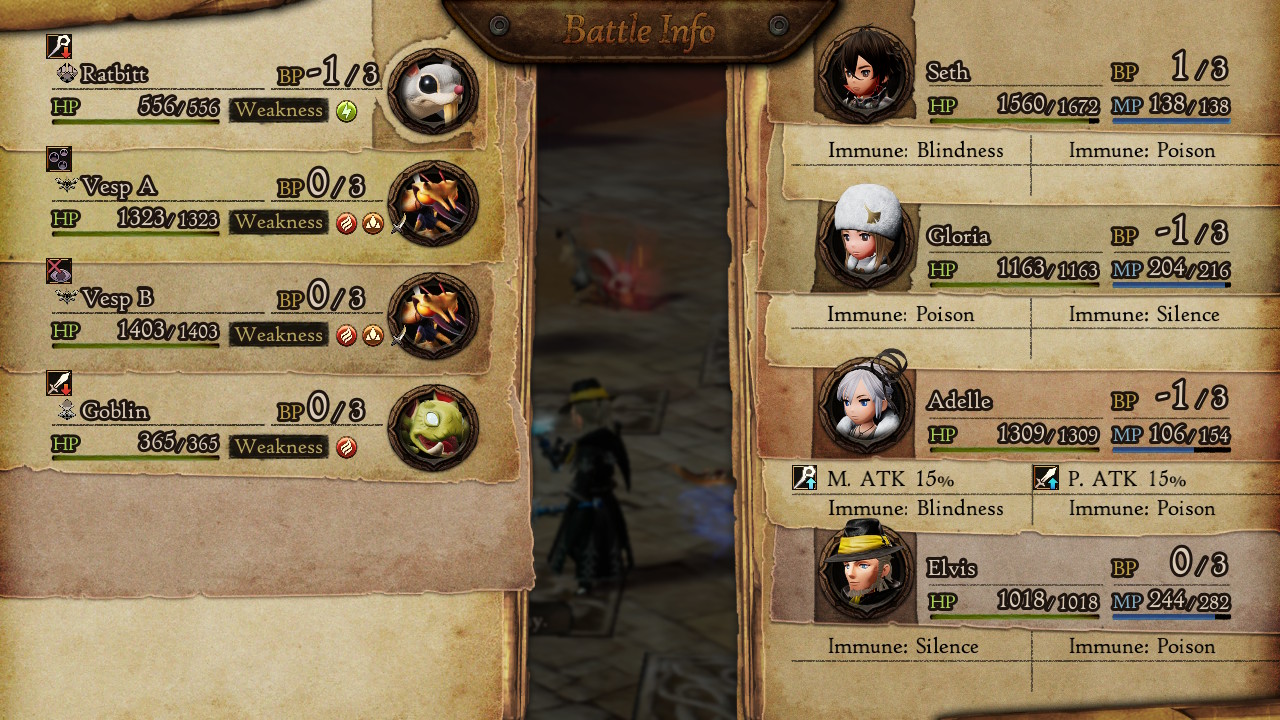
There is a clear desire to inform the player more, but only half the job is done. Buying new gear in shops will show you only some of the stats it would change on characters. Status effect icons blink the turn before they run out, but it is never clear how many times characters can act in a round, nor is there any turn counter.
While this could make things perhaps too easy, the ability to know what order your characters act in would be beneficial. Some stat buffs and debuffs also seem to stack, something else that would have been nice to know.
Past games had you select your entire party’s actions at the start of the round, now you select each in turn. This is does offer much more control, but it is hindered without any reminder of who is going next, and the aforementioned lack of counters for status effects, buffs, and debuffs.
You can also choose to have tooltips permanently on or off. This floating text box can be obtrusive (especially in gear menus), and having it assigned to a button you hold to temporarily bring up would have been great (as it is in the Job selection menu).
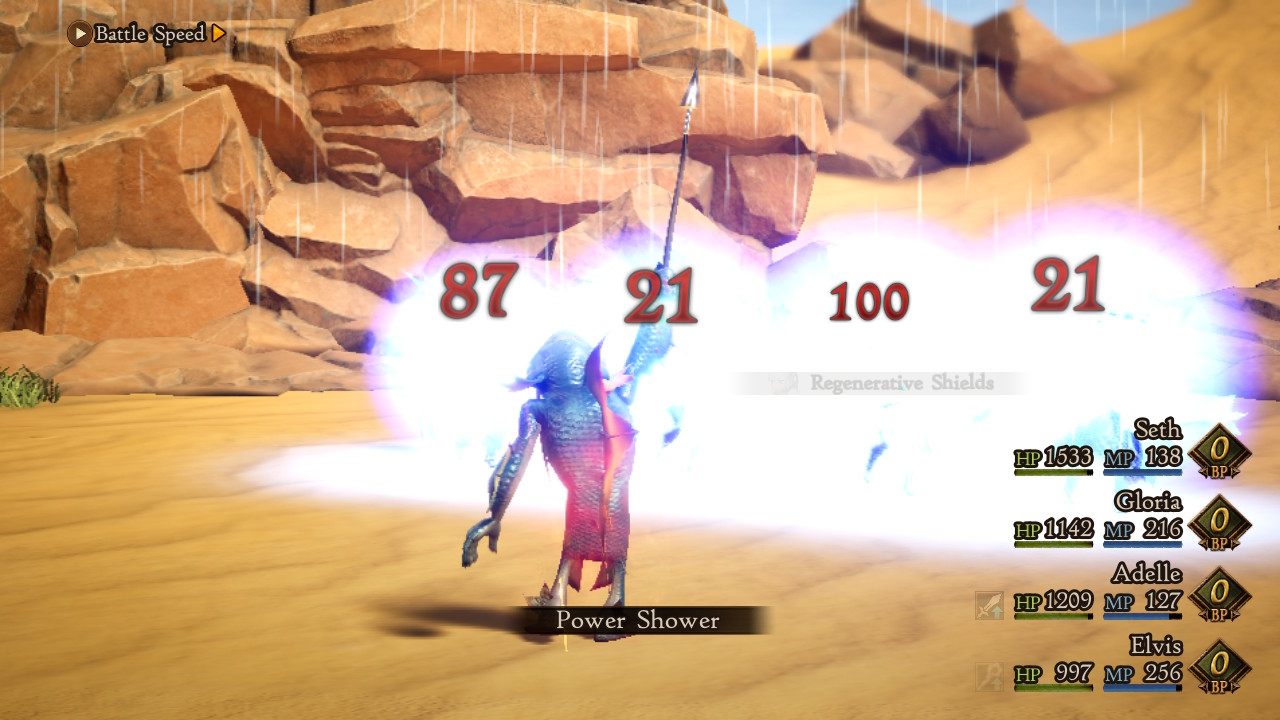
There are still some good quality of life improvements however, but each are undercut by a related flaw. When sufficiently leveled, weaker enemies will run from you (giving you time to catch up if you want to battle however).
Yet, some enemies will be too fast to outrun if they see you, and enemies respawn alarmingly fast. It wasn’t uncommon for me to re-fight a monster guarding a treasure chest I had just opened.
Your default walking speed is sufficiently fast (in addition to being able to run), but you do not snap to the direction you input. Instead you gradually turn around. This is a very minor gripe, but it results in talking to the wrong NPC more than once.
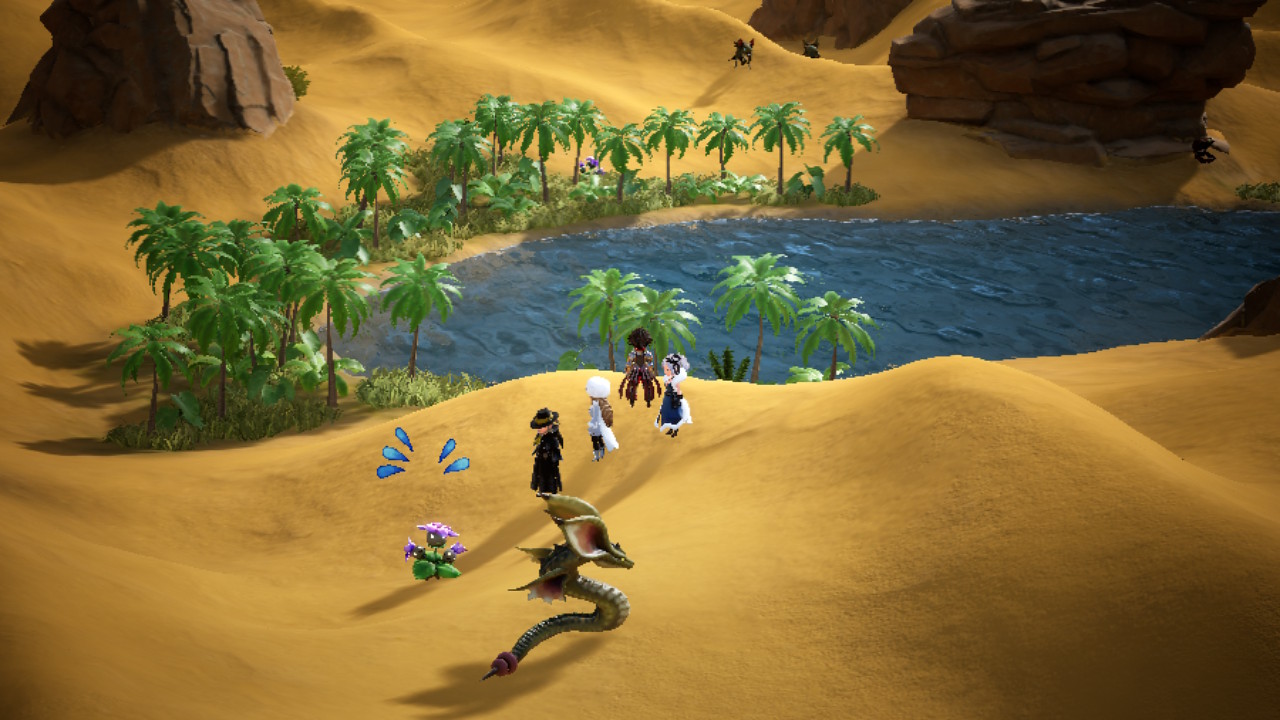
You can see enemies in the overworld, and preemptively strike them. However, the animation on your swing appears delayed, despite your attack still connecting much earlier. It is also used to cut grass for the chance of items, and it is a tedious addition not worth the investment.
While it sounds like I condemn nearly every new aspect of gameplay, this is far from the truth. Though I did suffer one crash, and loathe K.O.’ed party members not getting EXP; these are all issues that could be resolved with feedback, or are just my own bugbears. If not, they can easily be worked around or overlooked for what promises to be great JRPG character building and combat.
Even the slight tweaks to how Jobs affect gear and the turn system could have far bigger impacts that we won’t know until release. Nonetheless, I am eager even if it is more of the same from Bravely Default.
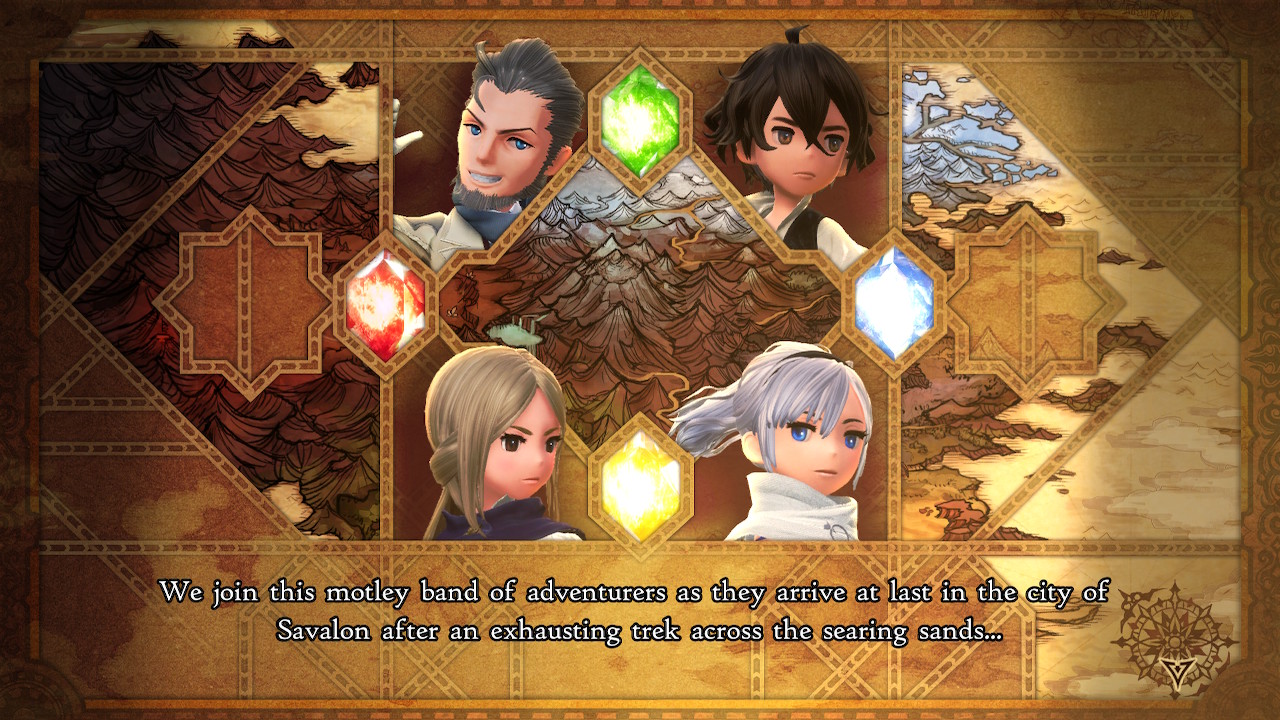
The plot is all very standard JRPG fare- at least what we know. The world’s four elemental crystals were snatched away when the kingdom of Musa fell. This has resulted in upheaval, such as a desert city becoming more flooded over the years.
Now, its surviving princess (Gloria), a shipwrecked sailor wishing to help (Seth), a scholar looking to unlock the secrets of a magic book (Elvis), and his bodyguard (Adelle) are trying to get them back.
Seth is brave and adventurous, but a little wide-eyed. Gloria is noble to a fault, and Adelle seems to bounce between playfully teasing and deadly serious. As everyone is so stock, the boisterous and fun-loving Elvis stands out, with even his lines in battle having more originality.
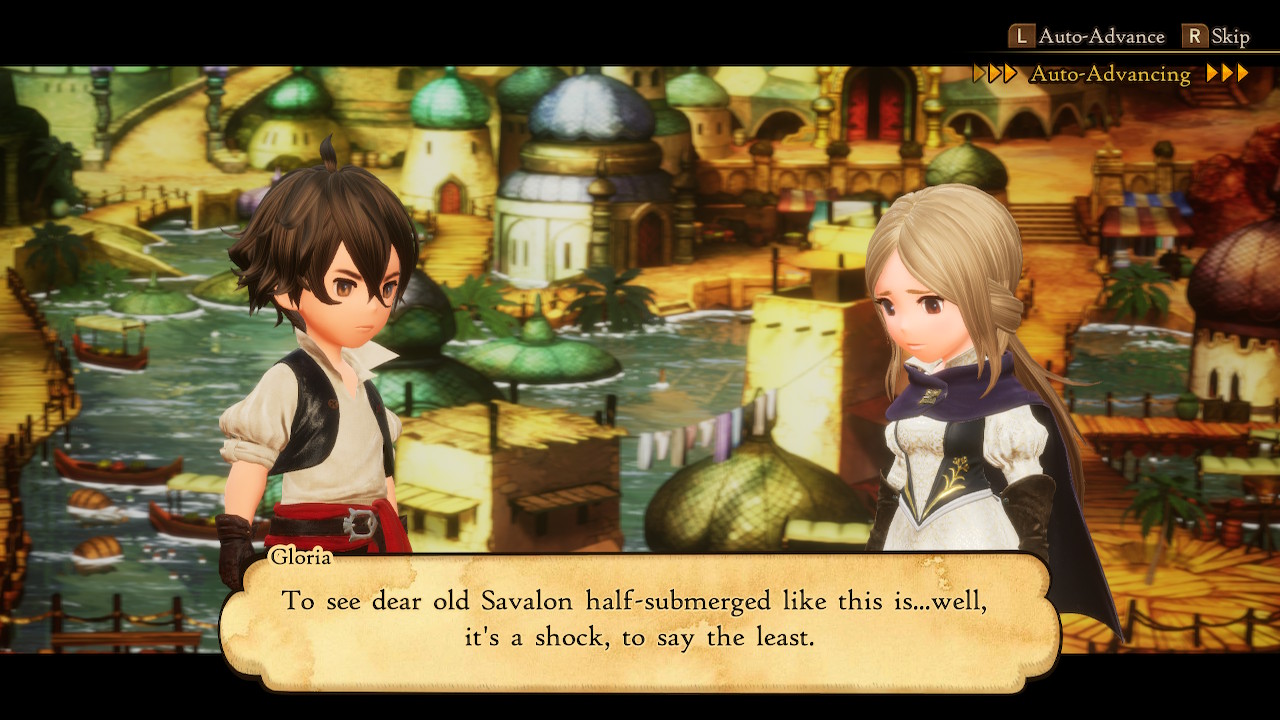
Speaking of, the dub voice cast sounds fantastic. Each of the main character’s accents either reinforces their backstory, or contradict it in a way that you are more intrigued. Elvis is supposedly a noble, but would seem more at home in the pub with the local common folk.
Compared to the Japanese dub, there are some oddities. Seth in Japanese has a deep, serious voice that growls in combat (as sailors tend to be a masculine symbol in Japan), betrayed by his slightly chibi appearance. In the English dub, Seth sounds much younger, and a little unsure of himself at times.
I oddly feel the English dub is more fitting in some cases, such as the above. Though this may be because of what I was exposed to first (and how young Seth looks in that particular case).
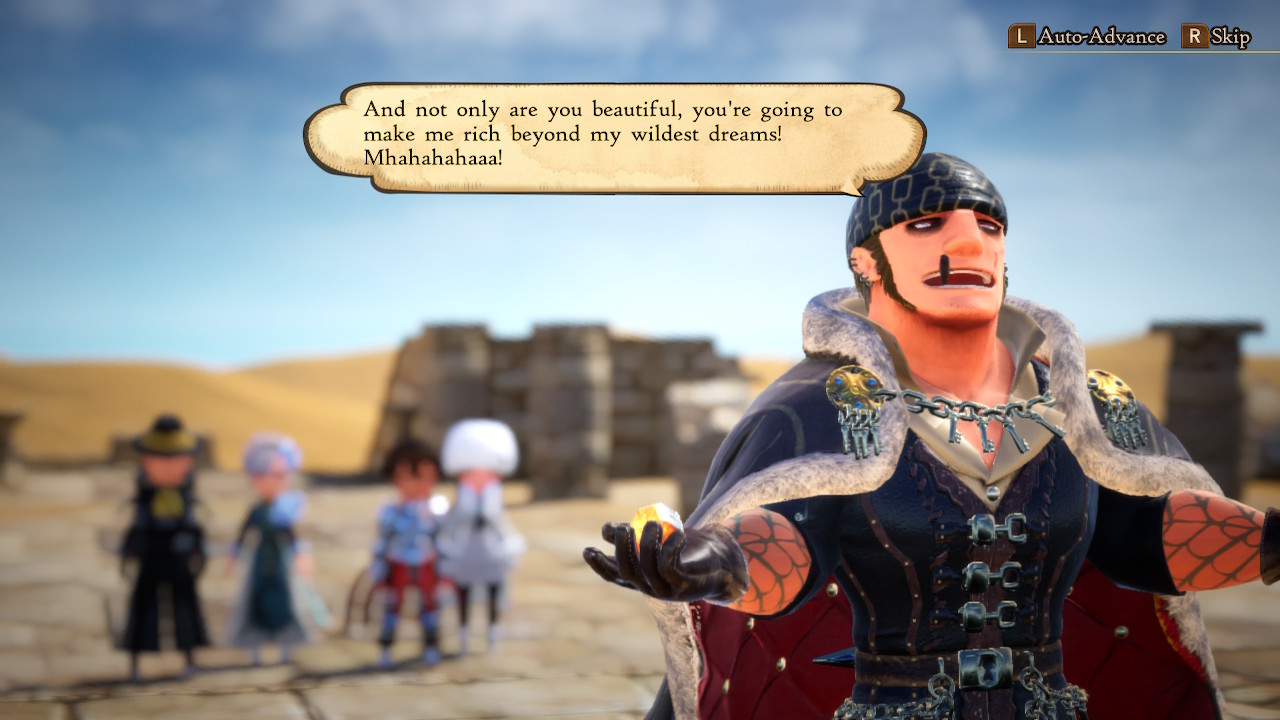
Japanese Elvis sounds more cool and collected, while the dub’s Scottish voice bleeds emotion and loves every bit of life. The demo’s boss (Bernard), sounds like a sinister kingpin-esque thug in Japanese. In English, his brutish appearance is juxtaposed by a gentlemanly self-proclaimed criminal genius.
It’s rare to see dubs be more fitting for a character, and rarer still for them to make a character more interesting. Whether these still match the final Japanese story and characters will remain to be seen.
Much like other games in the genre, the sound-bites characters say during battle can quickly grow repetitive to some. Speeding up battles can also result in multiple voice clips from the same character overlapping. Again, I hope the latter is fixed with feedback, though the former is a harder issue without more recordings of different lines.
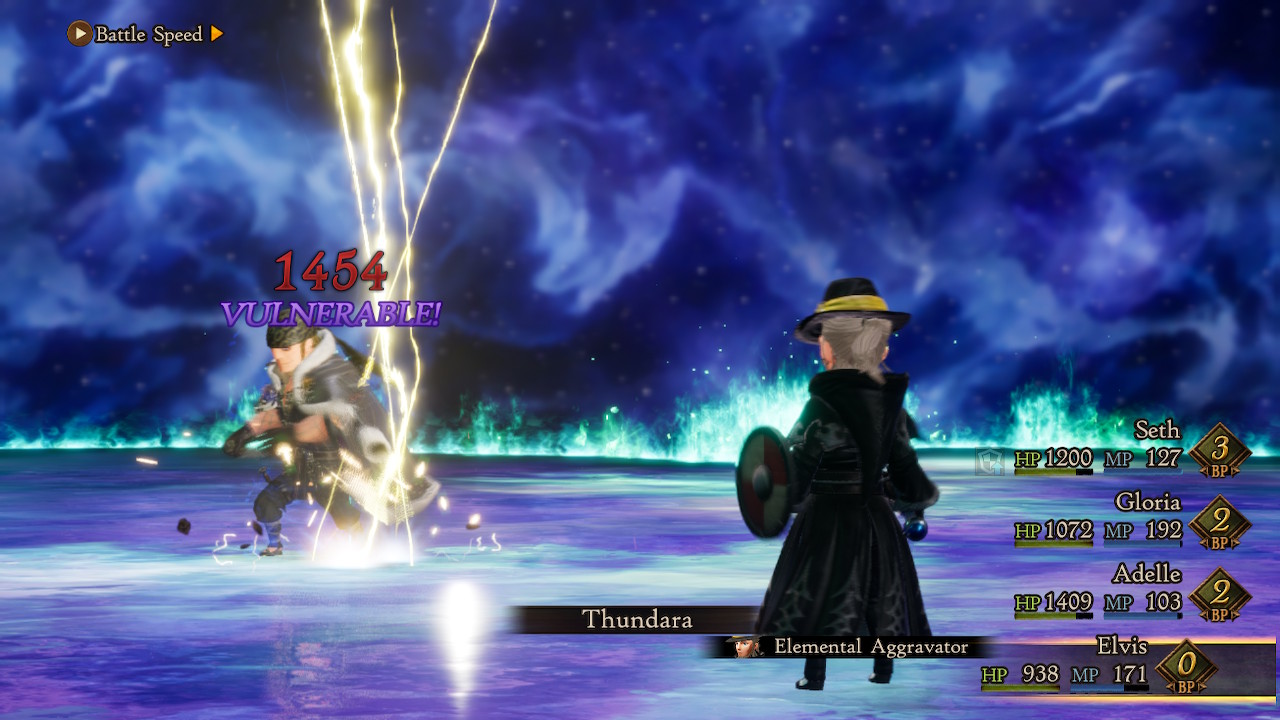
The music, much like the gameplay, continues what Bravely Default did. Horns and strings make battles sound epic and suspenseful, supported by a drum kit to keep things tense. The Job-holder boss stands out by having electric rock guitars and synths, emphasizing how they are fueled by otherworldly power.
Seth’s special attack is delightfully latin-inspired, with a flamenco guitar and castanets encouraging swift action. Meanwhile, the overworld is relaxing yet driving, as military drums, horns, and strings support a howling flute.
The arabic-inspired city of Savalon has the stereotypical arrangement and instruments you would expect. Ney flutes and oud guitars alternating as they lead in a meandering and swaying melody, while tribal drums and the odd zill keep pace.
While the soundtrack borders on what you would expect, there are a few earworms here and there, which all come rushing back when the first few bars are heard. There are even some leitmotifs and arrangements from past tracks, for fans of the series so far.
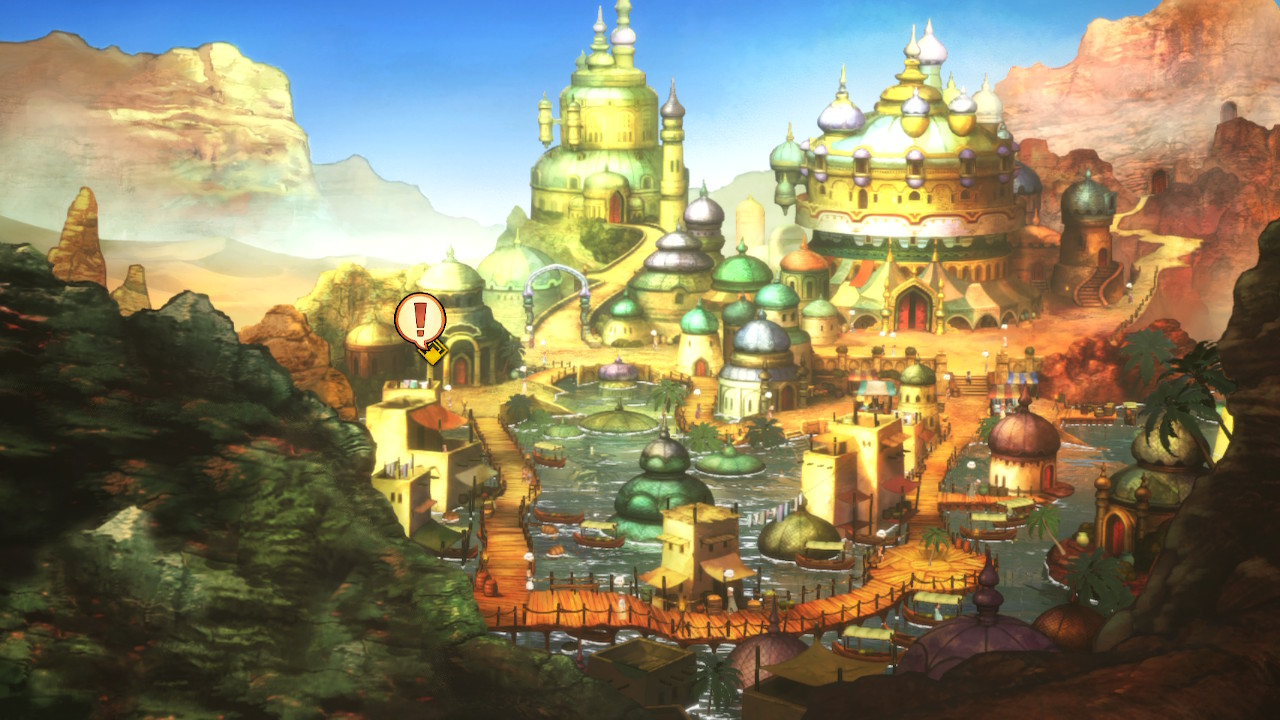
As in the original, backgrounds utilize a blend of 3D, cel-shading, and a painting effect. It looks better now it is not confined to the 3DS’ small resolution, with depth of field effects blending the line between background and modeled assets.
That being said, I did notice some split-second pop-in after an area loaded in the overworld, and some animations in battle tend to “snap” into place or awkwardly loop.
The latter symptom of the Unreal Engine but is easily fixed. The former shouldn’t be a limitation of the hardware, considering what is on display.
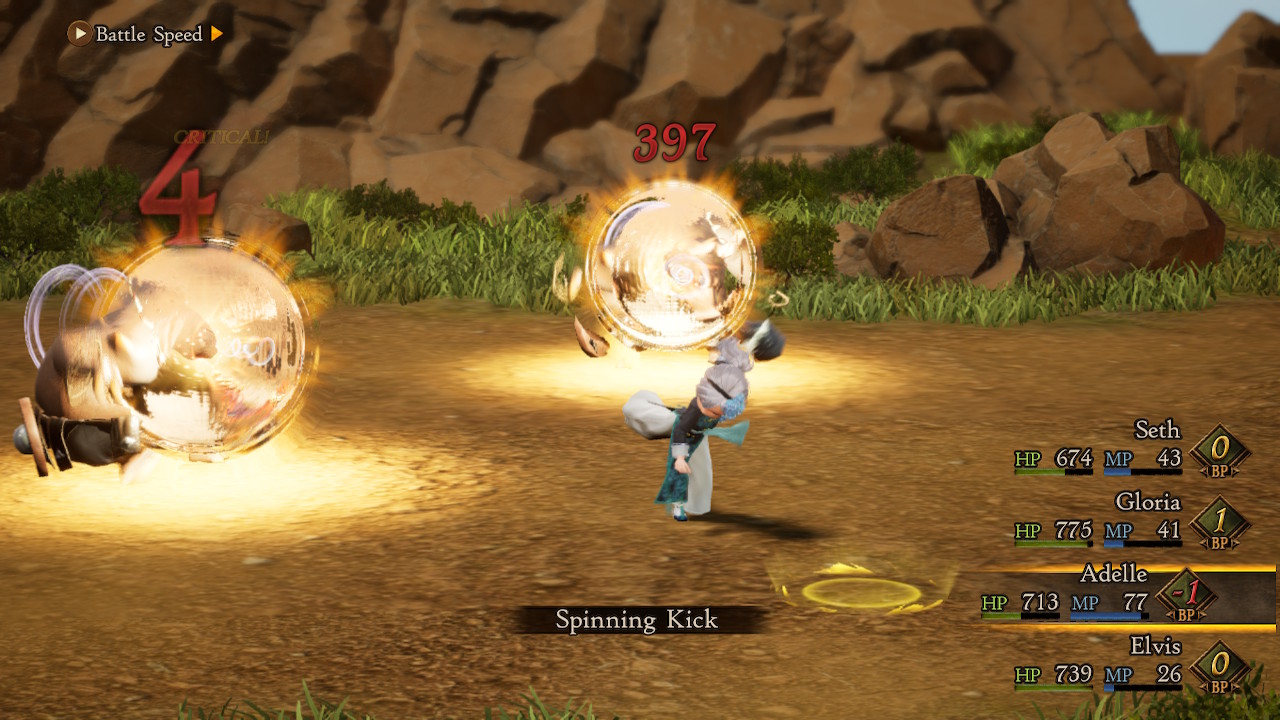
While most animations look great, it’s these moments that cast others in a worse light. Lip-synch is non-existent. The motion blur on attacks can be excessive for some. The depth of field effects in at least one cut-scene were so heavy, you’d question how short-sighted the cameraman is.
Given the effort put in across the board it’s surprising to see some cutscenes use the old presentation style. Everyone is shown from the knees up, talking above a dialog box, while they play canned animations that are slightly delayed and don’t always match the depth of the emotion of the character.
While the cutscenes in the dungeon were more what I was hoping to see (taking place in the dungeon itself, using different angles and perspectives), it appears towns and cities being built to be “front-facing” like their predecessor has caused some limitations to be made.
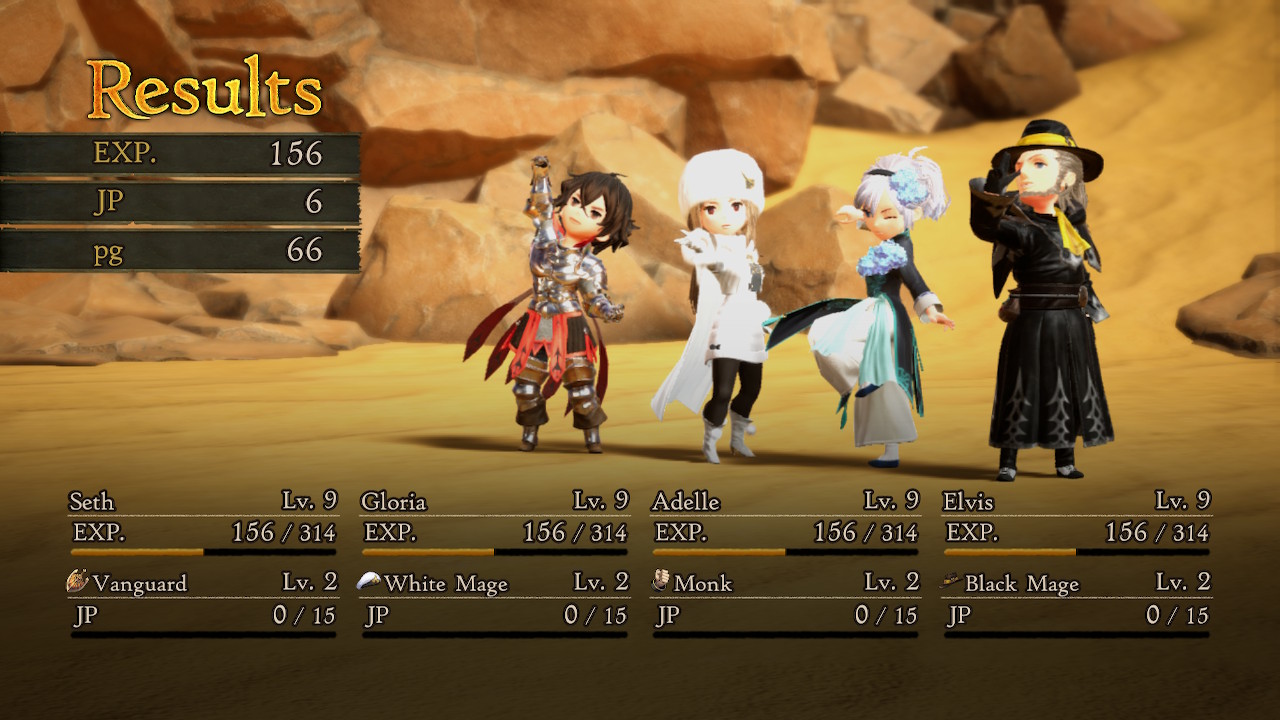
Graphically, and overall, Bravely Default II is shaping up to be a true upgrade of the first game. The vast majority of issues are minor at best, though the change to how turns work and only going half-way with information may be a major grievance to some.
UI and presentation also are great upgrades, marred by a few minor issues and one or two major ones. Hopefully, the developers still have time to patch up issues big and small.
We cannot be sure how the demo will reflect the final game, though everything has been promising. Even with the issues here, I am eagerly awaiting a release date.